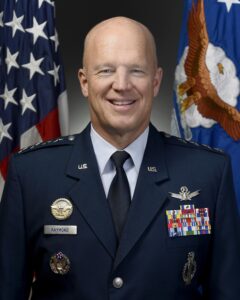Air Force Boosts Space With Elevation Of JFCC Space to 4 Star; STRATCOM Says…
Posted on

UPDATED: Adds AFSPC Head Raymond’s HASC Statement Confirming JFCC Elevation
CAPITOL HILL: Buried in the minutiae of the Senate Armed Service’s Committee’s space hearing is an important shift for space warfighting and acquisition.
Here it is: “… AFSPC/CC has been elevated to the Joint Force Component Commander for Space (JFCC Space) … in essence a 4-star Air Force commander focused on the joint fight.” Now, I think what they really meant to say is that the three-star joint component commander is being elevated to a four-star position. However the language is revealing since, to someone in uniform, any time you get to command combat troops is an “elevation” from a staff job.
The response we got this morning from Strategic Command (STRATCOM), where the JFCC Space resides, muddies the water a bit:
“The commander of Air Force Space Command (AFSPC) has not been elevated to the commander of Joint Functional Component Command for Space (JFCC Space). Gen. Raymond is still the commander of AFSPC and Lt. Gen. Buck is still the commander of our JFCC Space,” STRATCOM spokesman Lt. Col. Martin O’Donnell says in an email. “However, one of the things U.S. Strategic Command USSTRATCOM is exploring as part of an organizational restructure is the creation of a four-star joint force space component command (not JFCC Space). This restructure is in its nascent stage and is intended to build a more streamlined organization, enabling cleaner command and control of forces and lines of authority.”
Clearly, there’s still some discussion underway between the combatant command and the Air Force, but I understand the bottom line is that Raymond will be the joint component commander for space, even if he isn’t the JFCC Space…
UPDATE BEGINS: During a House Armed Services strategic forces hearing Friday morning, Gen. Raymond confirmed he will serve as the commander of joint space forces. Note the new term he offers for JFCC Space — Joint Forces Component Commander:
“In this realignment, I will serve as USSTRATCOM’s Joint Forces Space Component Commander, thus elevating the operational commander responsible for day-to-day space operations to a four-star position. This aligns the service component and joint forces component under one commander and elevates the component to a 4-star commander.”
UPDATE ENDS
What is also interesting in O’Donnell’s email is that he notes a “restructure” is underway “to reduce the 18 components that report on a variety of issues,” everything from cyber to space to missile defense to ISR and nuclear war. Significant forces in the Pentagon and Congress have been pushing for the elevation of Cyber Command to a combatant commander, for example. “While some organizations may change names or be absorbed into others, it would be premature to discuss specifics regarding the final USSTRATCOM structure as we continue to develop the implementation plan,” O’Donnell says. But my understanding is that the space part of this has been agreed to by the Air Force and the White House, so that should be it.

Gen. Jay Raymond Air Force Space Command
Huh, many of our readers, not steeped in the arcana of the Pentagon’s space enterprise, may be scratching their heads by this point. So this is what the change means, as best as I and a few Air Force officers and experts can tell:
“I think this could be very significant, as it would theoretically charge the same person with looking after training and equipping space forces and also doing the space ‘warfighting.’ Often times, those two functions are separated, which can lead to lack of coherence between what capabilities the warfighter needs, and what capabilities the services are actual developing,” opines Brian Weeden, one of the canniest military space experts around and a former nuclear missileer. He works for the Secure World Foundation. “The challenge is that it means doing two jobs, which is a lot more work.”
The current setup has the Joint Force Component Commander, Lt. Gen. David Buck, reporting to the head of Strategic Command, Gen. John Hyten. This is how STRATCOM serves as the combatant commander for space. The head of Air Force Space Command (AFSPC), Gen. Jay Raymond, sets the requirements for new space weapons, oversees Space and Missile Systems Command (which actually buys the satellites, sensors, launch and ground systems) and trains, equips and builds the space warfighting cadre. Even though its name would seem to indicate it possesses warfighting powers, AFSPC does not. With the change announced at yesterday’s hearing, that changes. The space commander now can command war in space.
One of the useful outcomes of combining these two positions, besides giving space the heft of another four-star and reducing the length of the chain of command, is that it may better force coordination of the development of satellites and their ground control systems through improvements to the requirements process.
UPDATE BEGINS Raymond addressed this in his Friday morning testimony:
“This best postures us to better integrate space capabilities into joint theater operations leading to normalized command relationships with theater commanders. Finally, this new role also effectively empowers the AFSPC Commander to better inform joint requirements. This should drive toward more integrated requirements consistent with Joint Requirements Oversight Council intent.” UPDATE ENDS
Today, ground stations and satellite development are often badly out of sync, with the US launching advanced satellites whose capabilities cannot be fully used because the ground systems they need don’t yet exist. This is not a new problem, but it is persistent and has resisted solution for at least a decade.
Weeden notes the elevation of JFCC Space to four stars may raise the issue “what this means for the development of senior space leaders. There are not that many space-focused 3-star billets out there, and in recent years the 3-star JFCC-Space billet was a key operational job in developing top space leaders. The current Commander of AFSPC, Gen. Jay Raymond, and one of his predecessors, General Shelton, both were JFCC-Space on the road to becoming AFSPC/CC. It’s not clear to me what impact the loss of one of the few 3-star space operations billets will have on the development of future space leaders.”
I think Air Force leaders would argue this should actually improve creation of new space leaders since it makes clearer who does what and should reduce the “pinging” between commands and commanders that occurs under the current setup. That should also speed and thus simplify acquisition decisions and will imbue requirements with the direct authority of the warfighter.
Many of the recent changes to Air Force space have come in the wake of Rep. Mike Rogers, chairman of the House Armed Services strategic forces subcommittee, speech to a closed audience at the Space Symposium that he planned to mandate creation of a Space Force.
“My vision for the future is a separate Space Force within the Department of Defense, just like the Air Force, which had to be separated from the Army in order to be prioritized and become a world-class military service,” he said. Since early April, the Air Force has created the A11, a new three-star deputy chief of staff for space, and made the move we detail in this story, a rapid pace for the space warfare community.
In addition to this change, the hearing testimony notes the Air Force is expanding what we used to call the JICSPOC, now known more prosaically as the National Space Defense Center. The testimony includes a rare bit of bragging about how the Air Force — not the National Reconnaissance Office (NRO) or other bits of the Intelligence Community — took “leadership” on the NSDC’s experimentation phase.
“The USAF has shouldered the preponderance of the resource responsibility in establishing the NSDC by freeing up facility space at Schriever Air Force Base, using USAF dollars and manpower to outfit those spaces, and providing the leadership that allowed for the execution of the experimentation phase,” the testimony says. “Furthering our commitment, we are now expanding (emphasis added) the existing NSDC floor space, upgrading the underlying infrastructure, outfitting the information systems, providing a large portion of the manpower to establish an around-the-clock operational capability that will play a key role in deterring any adversary that might consider extending a conflict to space, and to ensure critical space capabilities for our forces should deterrence fail.”
Add to that the elevation of the JFCC Space to four-star level, the bolstering of the Air Force role in space warfighting and the shortening of the joint command structure and you’ve got some serious improvements to how America will fight in space.
Subscribe to our newsletter
Promotions, new products and sales. Directly to your inbox.
